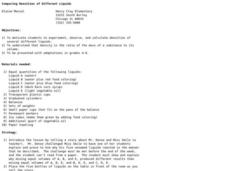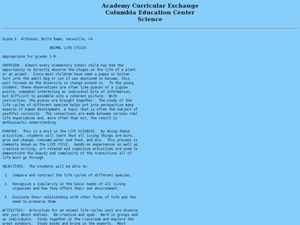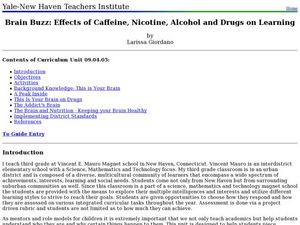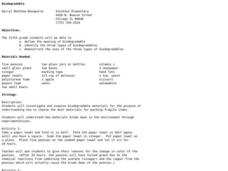Curated OER
Comparing Densities of Different Liquids
Students experiment with a variety of liquids to calculate density. In this integrated science and math lesson, students listen to a story in which the characters must prove and explain why 5 "mystery" liquids react in a certain manner....
Curated OER
Animal Life Cycle
Students conduct hands-on experiments. In this life cycle lesson, students are able to observe a variety of animals as they travel through their life cycle (brine shrimp, mealworms, frog eggs and chicken eggs). Students respond to what...
Curated OER
Taking Apart Owl Pellets
Students dissect an owl pellet. In this rodent and bone structure lesson, students work in groups to take apart an owl pellet. Students separate all the tiny bones from the fur and use the bones to reconstruct the rodent on a tag board....
Curated OER
Following The Sun
Students investigate botany by conducting a plant growth experience. In this sunlight lesson, students utilize two potted flowers, depriving one of direct sunlight, and recording their growth process in science journals. Students discuss...
Curated OER
Gone But Not Forgotten
Third graders examine animals and organisms that have become extinct and their similarities to living organisms. In this extinction instructional activity students divide into groups and research extinct animals.
Curated OER
Brain Buzz: Effects of Caffeine, Nicotine, Alcohol and Drugs on Learning
Students understand how the brain functions and how they can promote a healthy lifestyle. In this health lesson students complete several activities including investigating how stimulates affect the brain.
Curated OER
Sheep Heart Dissection
Fifth graders examine a sheep heart. In this biology lesson, 5th graders dissect a sheep heart to identify the parts of a heart including the aorta, valve, septum, and ventricle.
Curated OER
Machines All Around Us
Learners identify simple machines. In this physics lesson, students explore different rooms in the school building, looking for simple machines. Learners use a digital camera to take pictures of the simple machines.
Curated OER
The Planet Mars
Fifth graders gain knowledge about Mars and Earth. In this compare and contrast lesson, 5th graders use visual representations of the solar system to observe the characteristics of the planets. Students read fiction and nonfiction...
Curated OER
The Dance of the Butterfly
Learners explore butterfly life cycles and movement. In this integrated fine arts and biology life cycle lesson, students listen to the book The Very Hungry Caterpillar by Eric Carle and identify the related life cycle stages....
Curated OER
Learning the Parts of a Plant
First graders discover the anatomy of a plant by labeling a picture. In this botany lesson, 1st graders examine and dissect several real plants in class and define their different parts. Students utilize the Internet to view...
Curated OER
A House for Me- Ocean Environments
Students explore ocean environments. In this ocean environment lesson, students identify the things ocean animals need for survival. Students use KWL charts and search the Internet collecting information about ocean habitats....
Curated OER
Wether Prediction
Learners participate in a online weather course. They accurately forecast the weather and work through a series of four lessons. In addition, they present a weather forecast in front of the class, just like the weather people on...
Curated OER
Earth Changes
Students explore the make-up of the earth and the changes it undergoes in an earthquake. In this earth science lesson, students have two activities as part of a unit. First, to use a Styrofoam ball to model the earth's structure, and...
Curated OER
Diffusion of Molecules
Young scholars conduct a series of experiments to observe factors that impact molecular movement. In this molecular chemistry lesson, students drop food coloring in water with different properties (hot, with ice, with alcohol) and...
Curated OER
Looking At Variables
Learners predict and test different variables that would effect sugar cubes dissolving in water. In this dissolving lesson plan, students have 4 petri dishes with 4 different variations of sugar cubes and water. They predict which will...
Curated OER
Flight Paths of Orbiting Satellites
Students examine the path a satellite follows as it orbits the earth. In this space science activity, students use a globe as they illustrate a satellite in its orbital plane, then plot points on the satellite's path on the globe to see...
Curated OER
The Sense Of Touch
Students explore the sense of touch. In this science lesson plan, students participate in hands-on activities that broaden their perspectives pertaining the sense of touch.
Curated OER
How Plants Spice Up Our Lives
Third graders study plants. For this biology lesson plan, 3rd graders label and identify parts of plants, identify spices obtained from plants, and determine what part of a plant a spice comes from by using taste, touch, smell and sight.
Curated OER
Dispersement of Particles: Diffusion and Osmosis
Students explore the dispersement of particles. In this science lesson plan, students describe the many ways in which particles move and transfer from one source to other areas.
Curated OER
Biodegradable
Fifth graders experiment with biodegradable materials. In this science lesson, 5th graders perform a series of experiments, then discuss and chart their observations. Through the experiments, students will be able to identify three types...
Curated OER
Polymers: The Discovery
Students examine various polymers. In this polymers lesson, students perform three experiments with polymers to identify them and observe their interesting properties.
Curated OER
How Strong is the Solution
Young scholars investigate the strength of solutions. In this scientific inquiry lesson plan, students examine various solutions of food color and water as they discover the concentration of the solutions by adding bleach to clear the...
Curated OER
What's the Attraction
Students sort objects based on magnetism. In this magnetism lesson, students are given a variety of objects, then predict whether the object will be attracted to a magnet and test their hypothesis as they sort the objects into "yes" and...























